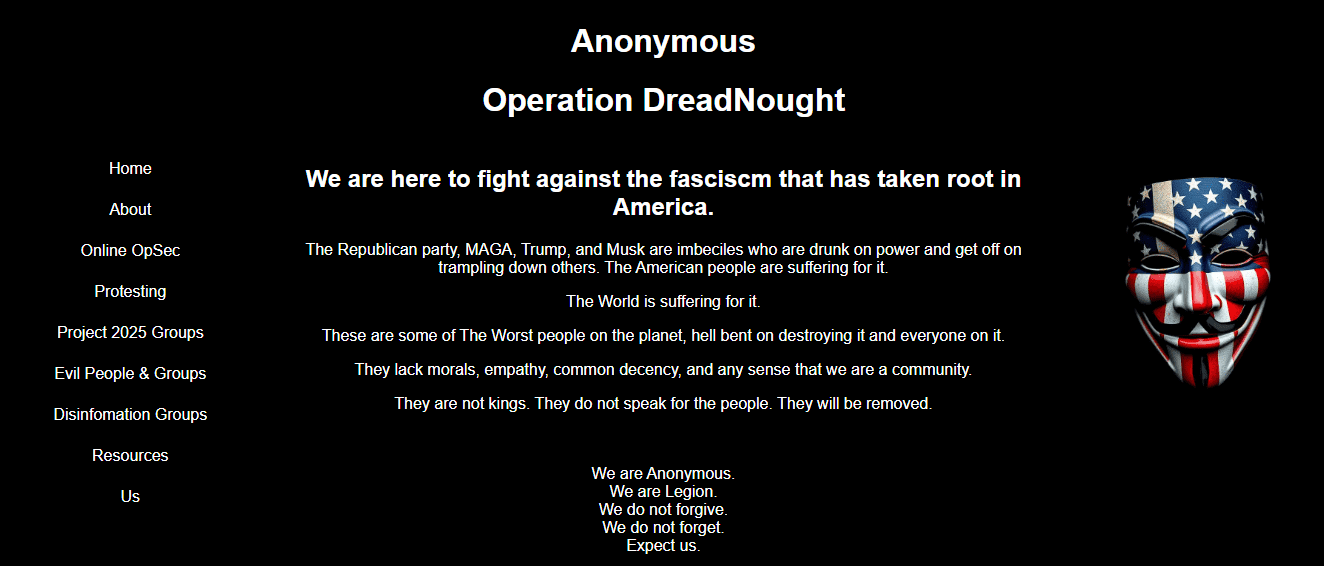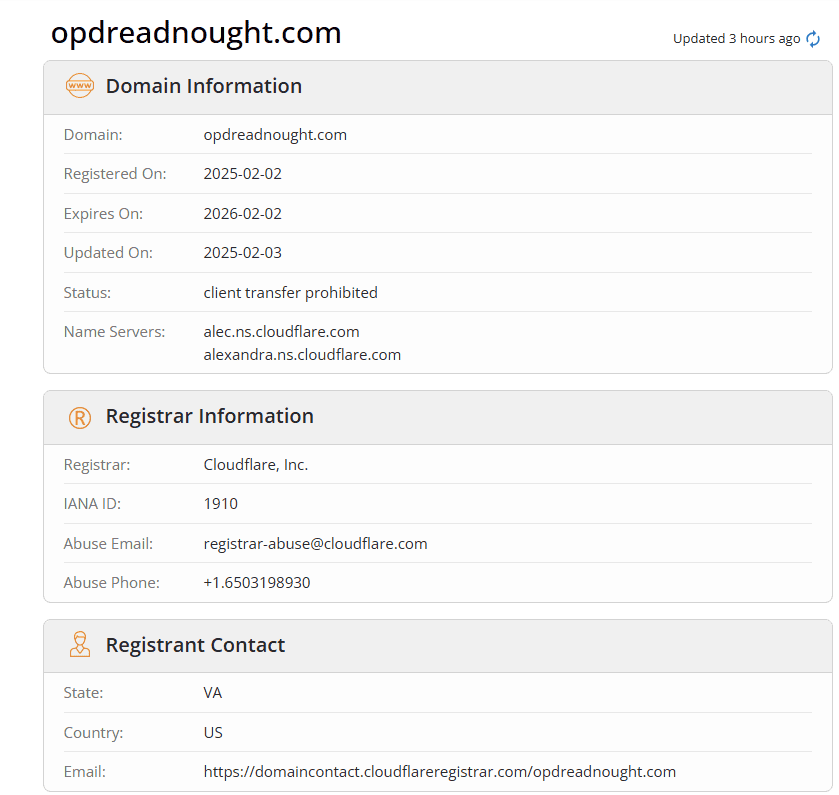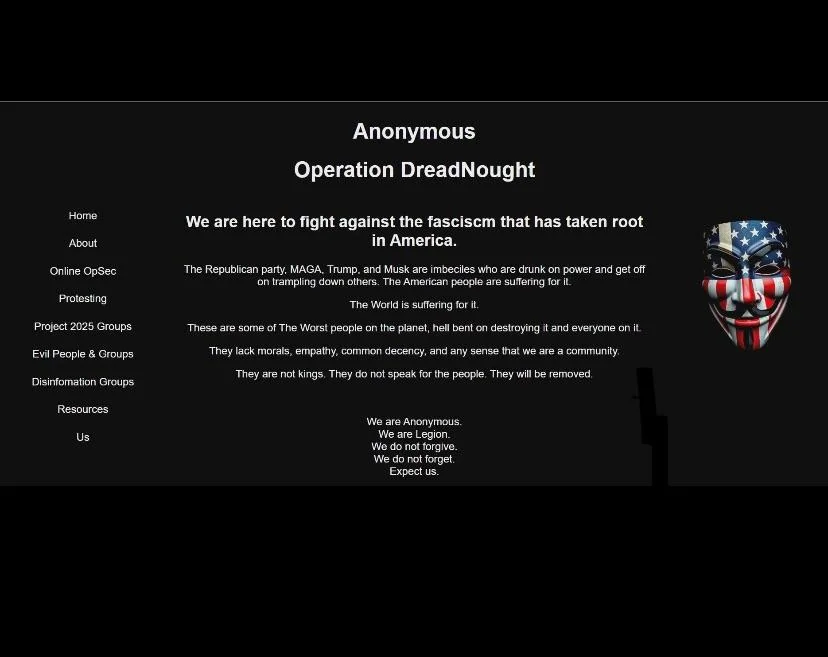In what could be a bold declaration that reignites fears over digital warfare and cyber activism, the hacktivist collective Anonymous has claimed responsibility for a massive cyberattack on X (formerly known as Twitter). We say “could be” because there’s still a little uncertainty over whether or not the posting is really from Anonymous or a possible impersonator. There is a debate going on and we won’t know until we see how this plays out – but if it turns out to be a coordinated effort from the group which has been mostly quiet in recent years it could be a huge development.
The following message was posted on the domain opdreadnought.com:

When you look at the Whois information for the domain it was registered on February 2, 2025 so the fact that it isn’t something purchased today does give it a little bit more credence:

The attack crippled the platform for several hours earlier today, preventing millions of users worldwide from accessing services. Anonymous announced the operation through its Operation DreadNought channels, framing the attack as part of a larger campaign against what they describe as rising fascism and authoritarianism in the United States.
This marks one of the most significant cyber incidents targeting X since Elon Musk’s controversial takeover in late 2022, and it raises serious questions about the platform’s vulnerability to politically motivated cyberattacks.
Inside the Attack: What Happened to X?
The disruption began early this morning, with widespread user reports of login failures, broken timelines, and complete service outages. Independent monitoring services such as Downdetector documented over 50,000 outage reports within the first hour, with issues peaking in North America and Europe.
Shortly after the disruptions went public, Elon Musk confirmed on his own platform that X was under what he described as a “massive cyberattack.” He hinted at possible nation-state involvement but did not provide evidence. The attack was later identified as a Distributed Denial-of-Service (DDoS) attack—a common tactic in hacktivism where attackers flood servers with overwhelming traffic, making services inaccessible.
Why X Is a Target
Cybersecurity experts point out that X’s new direction under Musk—marked by layoffs in the security and content moderation teams, as well as controversial policy changes—has made it a lightning rod for cyber activism and digital protest. By scaling back moderation and reinstating previously banned accounts, X has been accused of becoming a haven for disinformation, hate speech, and extremist content.
This ideological shift appears to have drawn the attention of Anonymous, which has a long history of opposing groups they perceive as promoting oppression, censorship, and authoritarianism.
Anonymous’ Statement: Operation DreadNought in Action
The group’s official statement, posted on its Operation DreadNought website and social media channels, was scathing:
“The Republican party, MAGA, Trump, and Musk are imbeciles who are drunk on power and get off on trampling down others. The American people are suffering for it. The world is suffering for it.”
They further warned:
“They are not kings. They do not speak for the people. They will be removed.”
The message ended with their well-known signature:
“We are Anonymous. We are Legion. We do not forgive. We do not forget. Expect us.”
Operation DreadNought appears to be Anonymous’ latest organized effort, targeting not just X but also what they label as far-right political movements and prominent figures they accuse of enabling authoritarian ideologies.
Who Is Anonymous, and Why Does It Matter?
Anonymous is not a centralized organization but a loosely associated international network of activist and hacktivist entities. Emerging from imageboards like 4chan in the mid-2000s, Anonymous has conducted numerous operations over the years—ranging from attacks on the Church of Scientology (Project Chanology) to digital assaults on ISIS propaganda channels.
What sets Anonymous apart from many cyber threat actors is their focus on political and social activism, often in support of free speech, anti-censorship, and human rights causes. However, their decentralized nature means anyone can claim affiliation, making attribution murky.
Operation DreadNought has sparked debate within cybersecurity circles about whether this is an authentic Anonymous operation or an opportunistic group leveraging the brand’s notoriety. Regardless, the damage inflicted on X is very real.
Dark Storm Team Also Claims Responsibility
Complicating matters further, a lesser-known hacking group called Dark Storm Team has also claimed responsibility for today’s attack. Emerging in 2023 as a pro-Palestinian hacktivist collective, Dark Storm Team has targeted government agencies and institutions across NATO countries and Israel. In their statement, they alleged responsibility for a DDoS attack on X but provided little supporting evidence.
Cybersecurity experts often caution that multiple groups claim credit for high-profile attacks. Without digital forensics and verified technical details, it’s difficult to determine who is truly behind an incident. Attribution in cyberattacks is notoriously complex, often requiring months of investigation.
Is X Prepared for a New Era of Cyber Warfare?
This attack raises serious concerns about the robustness of X’s security under Elon Musk’s leadership. Since his acquisition of the platform, Musk has laid off much of the workforce, including critical security teams, and has rolled back various content moderation policies.
Former Twitter security executives have warned that these moves leave the platform vulnerable to both internal and external threats. Alex Stamos, Facebook’s former Chief Security Officer, remarked in an interview last year that X was becoming a “soft target” for hacktivists and nation-states alike.
Even before this incident, X has been under scrutiny for data privacy issues, with multiple nations investigating its handling of user data.
The Bigger Picture: Hacktivism in 2025
Today’s attack fits into a growing trend of hacktivism—cyberattacks carried out for political or ideological reasons rather than financial gain. In 2022 and 2023, groups like Killnet and NoName057(16) disrupted major Western institutions in retaliation for geopolitical events. The rise of hacktivism has blurred the line between activism and cyber warfare, with nation-states sometimes backing or tolerating these groups for their own strategic goals.
As election cycles intensify in the U.S. and Europe, cybersecurity experts predict a surge in politically motivated cyberattacks. Anonymous’ latest move could signal the beginning of an escalated digital campaign targeting political figures, corporations, and platforms they deem harmful.
What Happens Now?
X’s engineering and security teams are reportedly working with government agencies to assess the damage and harden defenses. While no data breaches have been confirmed, experts warn that DDoS attacks can sometimes serve as a smokescreen for more invasive operations, such as data theft or espionage.
Elon Musk has vowed to strengthen X’s cybersecurity infrastructure, but many remain skeptical. Whether X can withstand future threats in an increasingly hostile digital landscape remains to be seen.
For now, Anonymous has fired a digital warning shot—one that reminds the world that the battle over information, influence, and ideology is no longer confined to the streets or the ballot box. It’s playing out in cyberspace, and the stakes have never been higher.

Key Takeaways
- Both Anonymous and Dark Storm Team claimed responsibility for a DDoS attack that caused major service disruptions on X today.
- The hacking group posted a statement on their website detailing their involvement in the cyberattack.
- The attack raises serious concerns about X’s cybersecurity measures and potential vulnerabilities in its infrastructure.
Details of the Cyberattack
The attack on X occurred today through a sophisticated distributed denial-of-service (DDoS) method. This cyberattack disrupted services for millions of users and highlighted potential vulnerabilities in X’s digital infrastructure.
Nature of the Attack
The cyberattack appears to be a classic DDoS (distributed denial-of-service) attack, where multiple compromised systems flooded X’s servers with excessive traffic. This overwhelming volume of requests effectively shut down access to the platform for several hours.
Security experts note that this attack likely used a botnet—a network of infected computers controlled remotely. The attackers coordinated these resources to target X’s main service nodes simultaneously, preventing legitimate users from accessing the site.
The attack began around 9:30 AM EST and continued for approximately four hours before X’s cybersecurity team could mitigate its effects. No personal data or sensitive information appears to have been compromised, as DDoS attacks typically aim to disrupt service rather than steal data.
Target and Impact
The cyberattack specifically targeted X’s main user authentication servers and content delivery networks. This strategic focus maximized disruption across the platform’s global user base of over 300 million active accounts.
Users reported complete inability to access the service, with login attempts failing and timelines not loading. Business accounts and advertisers faced significant impacts, as scheduled posts and campaigns could not be delivered during the outage.
X’s stock price dropped 3.2% following news of the attack. The company’s cybersecurity response team implemented defense measures including traffic filtering and server capacity increases to restore service.
This marks the third major cyberattack on a social media platform in 2025, highlighting the ongoing challenges these companies face in maintaining service resilience against increasingly sophisticated threat actors.
Anonymous’s Claim and Response
The hacktivist group Anonymous has officially claimed responsibility for today’s cyberattack on X (formerly Twitter), releasing statements through multiple channels. Their actions have prompted responses from cybersecurity experts and government officials worldwide.
Statement from Anonymous
Anonymous published a statement on their website claiming they orchestrated the distributed denial-of-service (DDoS) attack that temporarily disabled X on March 10, 2025. The group cited “protecting freedom of speech” as their primary motivation.
“Today’s action demonstrates that no platform is beyond accountability,” read part of their statement. The group also expressed support for the DarkStorm team, which was mentioned in related posts on various platforms.
Through their official X account @YourAnonNews, the group mocked X’s attempts to mitigate the attack, specifically noting: “It’s funny that Twitter is trying to use Cloudflare to circumvent the attack.”
Security experts have verified the authenticity of these claims based on the attack patterns and communication channels used.
Global Reactions and Measures
Cybersecurity firms have mobilized to analyze the attack vectors used against X. Cloudflare reported an unprecedented surge in malicious traffic targeting X’s servers.
Government agencies in several countries have issued alerts about potential escalation. The attack follows a pattern of recent hacktivist activities against major tech platforms.
X has implemented emergency security protocols and is working with external security partners to restore full service. A company spokesperson stated they are “taking all necessary measures to secure user data.”
Some analysts have connected this incident to broader cyber conflicts involving state actors, though no direct evidence links Anonymous to any government.
Tech communities have expressed mixed reactions, with some supporting the group’s stated principles while condemning the methods employed.
Frequently Asked Questions
The recent cyberattack on X has raised several important questions about Anonymous, their methods, and potential impacts. Many users and organizations are seeking clarity on the attack’s origins, motives, and consequences.
What are the motives behind the recent cyberattack attributed to the hacking group Anonymous?
Anonymous claims the attack on X was motivated by concerns over free speech and censorship on the platform. The group’s statement suggests they targeted X due to recent policy changes that they believe restrict user expression.
The hackers also mentioned corporate accountability as a key motivation, citing what they described as a lack of transparency in X’s operations since its ownership change.
How was the cyberattack carried out by Anonymous confirmed, and what evidence supports their claims?
Anonymous posted a statement on their website taking credit for the Distributed Denial of Service (DDoS) attack. Security experts have verified that the attack signatures match previous Anonymous operations.
X’s technical team confirmed the platform experienced a coordinated DDoS attack consistent with the timeline provided in Anonymous’ statement.
Several cybersecurity firms have analyzed the attack patterns and noted similarities to previous incidents attributed to Anonymous, though absolute confirmation remains challenging due to the group’s decentralized nature.
What are the potential repercussions of the cyberattack claimed by Anonymous on targeted organizations?
Organizations targeted by Anonymous often face immediate service disruptions and potential data security concerns. X reported several hours of downtime, affecting millions of users worldwide.
Financial impacts can be significant, with estimates suggesting large platforms like X can lose hundreds of thousands of dollars per hour of downtime.
Reputational damage may prove more lasting than technical issues, as users and advertisers may question the platform’s security infrastructure and resilience against future attacks.
Has Anonymous announced any specific goals or conditions in relation to the cyberattack?
Anonymous’ statement outlined three specific demands: greater transparency in content moderation policies, reversal of recent changes limiting certain speech categories, and improved data privacy protections for users.
The group indicated this attack was “just a warning” and suggested more significant actions would follow if their conditions weren’t addressed within 30 days.
No specific requests for payment or other traditional ransom demands were included in their communications.
What cybersecurity measures are being suggested in response to the tactics employed by Anonymous in the recent cyberattack?
Cybersecurity experts recommend implementing robust DDoS protection services and traffic filtering systems as immediate defensive measures against similar attacks.
Organizations are advised to review their incident response plans and conduct regular security drills to prepare for potential future attacks.
Increasing server capacity and implementing cloud-based protection services can help distribute and absorb attack traffic, minimizing service disruptions during DDoS events.
How is the international community reacting to the latest cyberattack attributed to Anonymous?
Several government cybersecurity agencies have issued statements monitoring the situation, with some offering technical assistance to affected organizations.
Digital rights organizations have expressed mixed reactions, with some supporting the underlying concerns while condemning the methods used to express them.
International technology forums have created working groups to discuss improved collaborative defense mechanisms against politically motivated cyberattacks.






